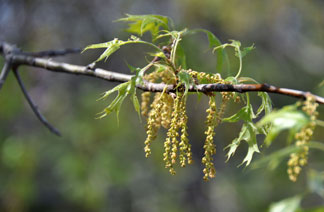PIN OAK
|
 |
| File Size: 61 KB |
|
|
|
Quercus palustris Muenchh.
|
| Harvey County, Kansas |
| Height: 40-80 feet |
| Family: Fagaceae - Oak Family |
| Flowering Period: April, May |
|
| Trunks: | | Straight, diameter 1-2 feet; crown pyramidal or oblong; lower branches drooping, middle branches nearly horizontal, upper branches ascending; bark thick, grayish-brown, smooth or with broad, shallow furrows, ridges flat-topped. | | Twigs: | | Slender, stiff, pin-like, initially dark red, woolly, becoming reddish-brown to grayish-brown, glabrous, shiny; leaf scars half-round; bundle scars 10 or more; terminal bud about 1/8 inch long; lateral buds clustered at tip of twig, egg-shaped or conical, 1/8 to 1/6 inch long, pointed, reddish-brown, glabrous or with few hairs at tip. | | Leaves: | | Alternate, simple, deciduous, leathery, egg-shaped in outline, 2 to 6.4 inches long, 2 to 4.8 inches wide; lobes 5-7, slender, few-toothed, usually tapering at right angles to midrib; apex sometimes expanded, bristle-tipped; sinuses deep, often approaching midrib, wide, rounded; upper surface dark green, glabrous, shiny; lower surface paler, hairs in vein axils; stalk .8 to 2.4 inches long, slender, glabrous; base wedge-shaped to broadly blunt or cut straight across; stipules linear or oblanceolate, 1/4 inch long; unfolding leaves reddish-brown, hairy; in autumn, initially turn scarlet, become brown, often persist on tree during winter. | | Flowers: | | With the leaves, monoecious; staminate catkins 2 to 3 inches long, drooping, loosely-flowered; flowers small, brownish, hairy, sessile or with short pubescent stalk; calyx bell-shaped, 3-5-lobed, tip acute, ciliate; stamens 4-6; anthers yellow; pistillate flowers at base of leaves on new growth, small, spherical, green; stalks short; involucre scales woolly; styles 3, curved outward, green with pink tip; stigmas 3-lobed, flattened, recurved, red. | | Fruit: | | Autumn of second year; acorn, sessile or short-stalked; cup saucer-shaped, shallow, 2/5 to 3/4 inch wide, 1/8 to 1/4 inch high, enclosing only base of nut; cup scales triangular, reddish-brown, closely appressed, pubescent or glabrous, margins dark; nut dome-shaped to egg-shaped, 1/2 to 3/5 inch long, 2/5 to 3/5 inch in diameter, often ridged, light brown, base flattened; kernel bitter. | | Habitat: | | River bottoms on rich moist soil but also may be found on rocky wooded hillsides on poorly drained clay soils. | | Distribution: | | East 1/3 of Kansas | | Origin: | | Native | | Uses: | | Native American steeped the inner bark and took the liquid for intestinal pains. Squirrels, blue jays, and wood ducks eat the nuts. Planted as a street and residence ornamental tree. The wood is used for interior finishes, railroad ties, and to make pins and small pegs for fasteners. | | Comments: | | The common name alludes to the short twigs which resemble pin-like spurs. The wood is hard, heavy, strong, coarse-grained, light brown with a thin, darker sapwood. It often has many small knots. |
|
| Pin oak staminate flowers |  | | 57 KB | | Harvey County, Kansas |
| | Pin oak |  | | 160 KB | | Harvey County, Kansas |
| | Pin oak bark |  | | 152 KB | | Riley County, Kansas |
| | Pin oak leaf |  | | 61 KB | | Mitchell County, Kansas |
| | Pin oak leaves |  | | 86 KB | | Riley County, Kansas |
| | Pin oak staminate flowers |  | | 74 KB | | Mitchell County, Kansas |
| | Pin oak staminate flowers |  | | 66 KB | | Mitchell County, Kansas |
| | Pin oak acorn |  | | 74 KB | | Mitchell County, Kansas |
| | Pin oak acorn |  | | 57 KB | | Mitchell County, Kansas |
| | Pin oak |  | | 119 KB | | Mitchell County, Kansas |
| | Pin oak buds |  | | 19 KB | | Mitchell County, Kansas |
| | Pin oak pistillate flowers |  | | 41 KB | | Mitchell County, Kansas |
| | Pin oak buds |  | | 23 KB | | Mitchell County, Kansas |
| | Pin oak buds |  | | 23 KB | | Mitchell County, Kansas |
| | Pin oak acorn |  | | 68 KB | | Brown County, Kansas |
|
|
|
|